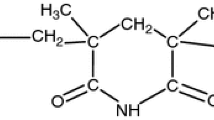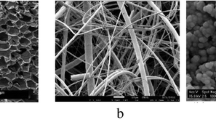Abstract
Polyimide foam (PF) is a low-thermal conductivity and lightweight material with high resistances against heat, protons, and UV irradiation. A new thermal insulation composed of PFs and multiple aluminized films (PF–MLI) has potential to be used in outer space as an alternative to conventional multilayer insulation (MLI). As fundamental numerical data, the effective thermal conductivity of PF in wide ranges of density and temperature need to be determined. In the present study, thermal-conductivity measurements were performed by both the periodic heating method and the guarded hot-plate method in the temperature range from 160 K to 370 K and the density range from 6.67 \(\mathrm{kg} \cdot \mathrm{m}^{-3}\) to 242.63 \(\mathrm{kg}\cdot \mathrm{m}^{-3}\). The experiments were carried out in a vacuum and under atmospheric pressure. For confirmation of the validity of the present guarded hot-plate apparatus under atmospheric pressure, the effective thermal conductivity of the lowest-density PF was measured with the aid of the heat flow meter apparatus calibrated by the standard reference material (NIST SRM 1450c) in the temperature range from 303 K to 323 K. In order to cross-check the present experimental results, the temperature and density dependences of the effective thermal conductivity of PF were estimated by means of the lattice Boltzmann method based on a dodecahedron inner microscopic complex structure model which reflects a real 3D X-ray CT image of PF.









Similar content being viewed by others
References
S. Okazaki, M. Murakami, H. Kawasaki, T. Yabe, Y. Kanamori, “Experimental Study of Influence of Processing on MLI Performance for Space Use,” in 38th International Conference on Environmental Systems, SAE-2008-01-2067, San Francisco, CA (2008)
T. Ohmura, M. Tsuboi, in Proceedings of the 21st Japan Symposium on Thermophysical Properties, Nagoya, Japan (2000), p. 147
J. Paek, B. Kang, S. Kim, J. Hyun, Int. J. Thermophys. 21, 453 (2000)
Y. Hiasa, H. Nagano, A. Ohnishi, Y. Nagasaka, in Proceedings of the 8th Asian Thermophysical Properties Conference, No. 152, Fukuoka, Japan (2007)
M. Wang, N. Pan, Int. J. Heat Mass Transf. 51, 1325 (2008)
M. Wang, N. Pan, Mater. Sci. Eng. R 63, 1 (2008)
M. Wang, J. Wang, N. Pang, S. Chen, Phys. Rev. E 15, 036702 (2007)
UPILEX-FOAM DATA SHEET, UBE Industries, Ltd. (2000)
D. Kunii, J. Smith, AIChE J. 6, 71 (1960)
M.K. Williams, E.S. Weiser, J.E. Fesmire, B.W. Grimsley, T.M. Smith, J.R. Brenner, G.L. Nelson, Polym. Adv. Technol. 16, 167 (2005)
Y. Mizutani, T. Sugihara, S. Tachikawa, A. Ohnishi, K. Kajiwara, Y. Nagasaka, in Proc. 30th Japan Symposium on Thermophysical Properties, Yonezawa, Japan (2009), p. 262
E. Placido, M. Arduini-Schuster, J. Kuhn, Infrared Phys. Technol. 46, 219 (2005)
M. Wang, J. Wang, N. Pan, S. Chen, J. He, J. Phys. D 40, 260 (2007)
J. Wang, M. Wang, Z. Li, Int. J. Therm. Sci. 46, 228 (2007)
X. Hong, W. Di, S. Yuhe, Res. J. Appl. Sci. Eng. Technol. 6, 2520 (2013)
L. Gibson, M. Ashby, Cellular Solids: Structure & Properties (Pergamon Press, Oxford, 1988)
BIPM, IEC, IFCC, ISO, IUPAC, IUPAP, OIML, “Guide to the Expression of Uncertainty in Measurement” (International Organization for Standardization, Geneva, 1993)
R.R. Zarr, Standard Reference Materials: Glass Fiberboard, SRM 1450c, for Thermal Resistance from 280 K to 340 K. NIST Special Publication 260–130 (National Institute of Standards and Technology, U.S. Government Printing Office, Washington, DC, 1997)
Acknowledgments
The authors acknowledge Dr. Ohnishi (Institute of Space and Astronautical Science) for the initial concept on the present research and Messrs. Yasuhiro Hiasa, Takashi Sugihara, and Yuki Mizutani, students of Keio University at that time, for their assistance in carrying out experiments and calculations. The authors also wish to thank UBE Industries, Ltd. for supplying the polyimide foams. The work described in this paper was partially supported under a Grant-in-Aid for Scientific Research (S) (No. 24226006) from the Japan Society for the Promotion of Science (JSPS).
Author information
Authors and Affiliations
Corresponding author
Rights and permissions
About this article
Cite this article
Takagi, R., Tachikawa, S., Ohmura, T. et al. Measurement and Estimation of High-Vacuum Effective Thermal Conductivity of Polyimide Foam in the Temperature Range from 160 K to 370 K for Outer Space Applications. Int J Thermophys 35, 277–289 (2014). https://doi.org/10.1007/s10765-014-1605-5
Received:
Accepted:
Published:
Issue Date:
DOI: https://doi.org/10.1007/s10765-014-1605-5




